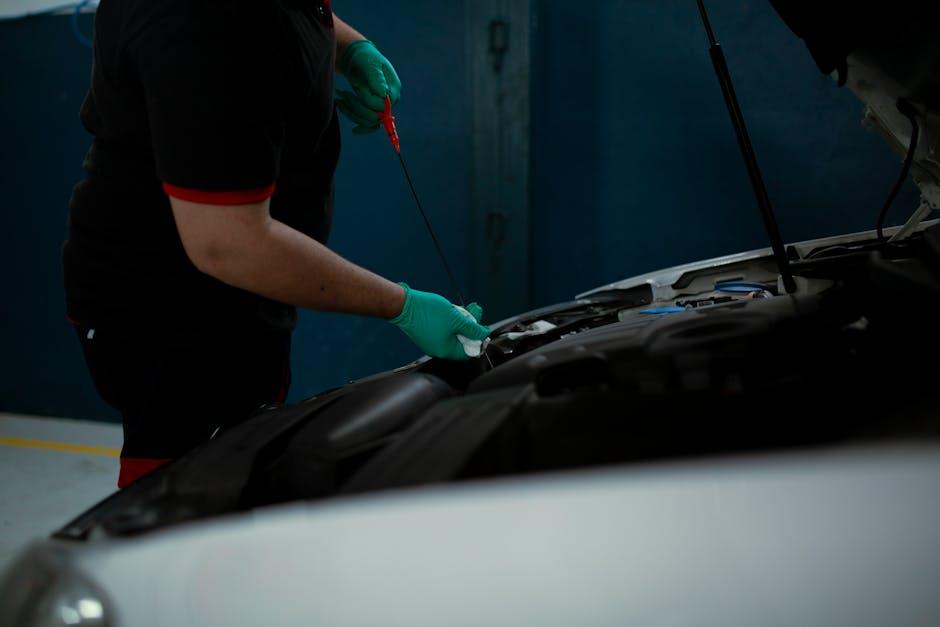Beneath the sleek exterior of every car lies a complex symphony of moving parts, all orchestrated to keep you moving smoothly down the road. Among these essential components, engine oil plays the starring role, silently lubricating, cooling, and protecting the heart of your vehicle. Knowing how to check your engine oil levels isn’t just a routine task—it’s a simple yet powerful act of care that can save you from unexpected breakdowns and costly repairs. In this guide, we’ll walk you through the straightforward steps to keep your engine’s lifeblood flowing just right, ensuring your vehicle runs at its best mile after mile.
Table of Contents
- Choosing the Right Environment for an Accurate Oil Check
- Understanding the Dipstick and Its Role in Oil Measurement
- Step-by-Step Guide to Safely Checking Your Engine Oil
- Interpreting Oil Levels and What They Mean for Your Engine
- Common Mistakes to Avoid When Checking Engine Oil
- When and Why to Top Up or Change Your Engine Oil
- Q&A
- In Summary

Choosing the Right Environment for an Accurate Oil Check
When determining the most suitable setting to check your engine oil levels, prioritize consistency and calmness. A stable environment ensures that the oil has settled in the pan, providing a true reading. Always perform this task on a flat surface—preferably a garage floor or driveway—to avoid misleading results caused by inclines. Avoid checking oil levels immediately after driving; the oil needs time to cool and drain back into the pan to prevent false low readings. This patience pays off by maintaining engine health and longevity.
Besides surface and engine temperature, consider lighting conditions and surroundings for maximum accuracy. A well-lit area helps you see the dipstick markings clearly, ensuring you identify the correct oil level. Keep in mind the following factors for an optimal oil check experience:
- Consistent ambient temperature to reduce fluid expansion or contraction
- Minimal distractions so you can focus on the task
- Proper dipstick placement when rechecking to avoid contamination or misreading
- Access to cleaning materials in case the dipstick needs a wipe before re-insertion

Understanding the Dipstick and Its Role in Oil Measurement
The dipstick serves as the quintessential tool for gauging your engine’s oil level, offering an immediate snapshot of your vehicle’s oil health. Typically made of metal or sturdy plastic, this slender rod is distinctly marked with minimum and maximum indicators that reveal whether your oil level falls within the optimal range. When removed, the dipstick flaunts an oily film that you can visually inspect for color and consistency, giving valuable hints about the oil’s age and condition. It’s a simple yet effective device designed to empower drivers with crucial information at a glance, preventing engine wear and tear caused by insufficient lubrication.
Understanding how to read the dipstick is just as important as locating it. When you pull it out after the engine has been off for a few minutes, be sure to wipe it clean and reinsert it fully before drawing it out again for an accurate reading. Here’s a quick checklist of what to look for:
- Oil level: Should rest between the low and high marks.
- Color and clarity: Fresh oil appears amber and translucent; dark or gritty oil signals a change is needed.
- Oil texture: Should feel smooth, not thick or sludgy.
| Dipstick Mark | Meaning |
|---|---|
| Low | Engine requires more oil |
| Full | Oil level is optimal |
| Overfull | Excess oil can damage engine seals |

Step-by-Step Guide to Safely Checking Your Engine Oil
Before you begin, make sure the vehicle is parked on a level surface and the engine is cool to avoid inaccurate readings or burns. Open the hood and locate the dipstick, usually marked with a bright handle. Pull the dipstick out fully, wipe it clean with a lint-free cloth, then reinsert it all the way back into its tube. This ensures you get an accurate measurement of the oil level on the next check.
Now, pull the dipstick out once more and examine the oil’s position against the marks. Look for the MIN and MAX indicators or crosshatch patterns. Your engine oil should lie comfortably between these levels, signaling safe ranges. If the oil appears low or is dark and gritty, it’s time for a top-up or an oil change. Pay attention to these signs to maintain optimum engine performance and longevity.
- Tips for accuracy:
- Always check oil when the engine is cold or after it has been off for at least 10 minutes.
- Use a clean rag to avoid contamination on the dipstick.
- Dispose of used rags safely to prevent environmental hazards.
| Dipstick Mark | Oil Level Status | Recommended Action |
|---|---|---|
| Below MIN | Low Oil Level | Add oil immediately |
| Between MIN & MAX | Optimal Level | No action needed |
| Above MAX | Too Much Oil | Drain excess oil |

Interpreting Oil Levels and What They Mean for Your Engine
Understanding what your engine oil levels indicate can save you from costly repairs and improve your vehicle’s performance. When the dipstick shows the oil near or below the minimum mark, it means your engine is running low on crucial lubrication, which can cause increased friction, overheating, and ultimately premature engine wear. Conversely, oil levels above the maximum mark can be just as problematic, leading to excessive pressure in the crankcase, oil foaming, and reduced lubrication efficiency.
Here’s a helpful guide to interpreting your oil dipstick readings and their implications:
- Below Minimum: Add oil immediately; continuing to run the engine at this level risks serious damage.
- Between Minimum and Maximum: Ideal range; the engine is properly lubricated and running smoothly.
- Above Maximum: Drain some oil or visit a mechanic to prevent pressure build-up or oil leaks.
| Oil Level | Possible Cause | Recommended Action |
|---|---|---|
| Low | Leak, Consumption, or Burn-Off | Top up oil & check for leaks |
| Optimal | Normal Operation | Maintain regular checks |
| High | Excess Additive or Overfill | Drain excess oil promptly |

Common Mistakes to Avoid When Checking Engine Oil
One of the most frequent errors is checking your engine oil immediately after turning off the engine. Because the oil has not yet returned to the sump, the reading can be misleadingly low. Always wait about 10-15 minutes to allow the oil to settle back into the pan for an accurate measurement. Additionally, failing to clean the dipstick before reinserting it can cause residue buildup, resulting in an incorrect oil level reading. Always wipe the dipstick clean with a lint-free cloth before reinserting it into the tube.
Another common pitfall involves misinterpreting the oil level markings on the dipstick. Some dipsticks have crosshatch areas while others have simple minimum and maximum lines; ignoring these differences leads to confusion. Overfilling oil can be just as harmful as running low, causing increased engine pressure and potential leaks. Below is a quick reference to help distinguish common dipstick markings:
| Marking Type | Description | Proper Action |
|---|---|---|
| Crosshatch Area | Shaded zone between min and max | Fill oil until the dipstick line is within this zone |
| Min/Max Lines | Two distinct lines | Keep oil level between these lines |

When and Why to Top Up or Change Your Engine Oil
Maintaining the right oil level is crucial for the longevity and performance of your engine. You should consider topping up your engine oil when the dipstick shows the level is below the minimum mark, or if your vehicle’s dashboard oil indicator lights up. Regularly topping up helps prevent increased friction and overheating, which can cause significant engine wear or failure. Keep in mind that topping up with the correct oil grade is essential—using the wrong type may compromise engine performance or even damage internal components.
Changing your engine oil, on the other hand, is an essential part of routine maintenance and should be done according to your vehicle’s service manual or more frequently if you drive under harsh conditions, such as extreme temperatures or off-road terrains. Old, degraded oil loses its ability to lubricate and protect the engine effectively, leading to sludge buildup and potential engine damage. To help you gauge when to top up or change your oil, check out the quick reference table below:
| Condition | Action | Frequency |
|---|---|---|
| Oil Below Min Mark | Top Up Oil | Immediately |
| Oil Dark & Dirty | Change Engine Oil | Every 3,000 – 7,500 miles |
| Dashboard Oil Warning | Check & Top Up/Change | Immediately |
| Harsh Driving Conditions | More Frequent Oil Changes | Consult Manual |
Q&A
Q&A: How to Check Engine Oil Levels
Q1: Why is checking engine oil levels important?
A1: Engine oil lubricates the moving parts inside your engine, preventing friction and overheating. Keeping the oil at the right level ensures smooth performance and helps avoid costly engine damage.
Q2: When is the best time to check your engine oil?
A2: The ideal time is when your car has been off for a few minutes and the engine is cool or slightly warm. This allows the oil to settle in the oil pan, giving a more accurate reading.
Q3: What tools do I need to check my engine oil?
A3: You only need a clean rag or paper towel and your car’s dipstick, which is usually marked with a bright handle and located near the engine.
Q4: How do I locate the oil dipstick?
A4: Open the car hood and look for a looped or brightly colored ring or handle. It’ll often be labeled with “oil” or an oil can icon. Consult your owner’s manual if you’re unsure.
Q5: What’s the step-by-step process to check the oil level?
A5:
- Park on a level surface and turn off the engine.
- Wait a few minutes for oil to settle.
- Pull out the dipstick and wipe it clean.
- Reinsert the dipstick fully, then pull it out again.
- Check where the oil film ends against the marked indicators on the dipstick.
Q6: How do I read the dipstick’s oil level?
A6: The dipstick usually has two marks: “Full” and “Add” (or “Min” and “Max”). Your oil level should fall between these marks. If it’s below the lower mark, it’s time to add oil.
Q7: What should the oil look like?
A7: Healthy engine oil is amber or light brown and translucent. If it’s dark black, gritty, or milky, this could signal the need for an oil change or a mechanical issue.
Q8: How often should I check my engine oil?
A8: Checking monthly is a good habit, especially for older cars or those with high mileage. Newer vehicles might have oil monitors but a manual check can reinforce peace of mind.
Q9: What if the oil level is too high?
A9: Overfilling can cause foaming and reduce lubrication, potentially damaging your engine. If you suspect overfilling, have a mechanic drain the excess.
Q10: Can I top up the oil myself?
A10: Yes, topping up is straightforward—just use the oil grade recommended by your manufacturer and add small amounts, checking the level frequently to avoid overfilling.
In Summary
Maintaining the right engine oil level is a simple yet essential habit that keeps your vehicle humming smoothly and extends its life. By taking just a few moments to check your oil regularly, you’re giving your engine the care it deserves—helping you avoid unexpected breakdowns and costly repairs down the road. So next time you pop the hood, remember: a little attention goes a long way in keeping your engine—and your journey—running strong.

